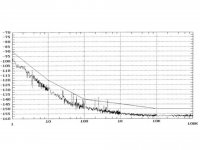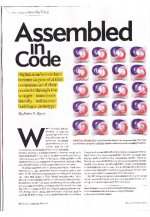These days the noise is not an issue, why shoot yourself in the foot use FFT's get the noise BW down to an insignificant number. Doubling the FFT length is the same as having two oscillators, the bits are way less pain.
Here is about as good as you will get today with ADC + FFT. I think it was a 500K point FFT. I have better illustrations I can post if interested.
http://www.diyaudio.com/forums/equi...0204-mods-fft-measurements-9.html#post3405296
Here is about as good as you will get today with ADC + FFT. I think it was a 500K point FFT. I have better illustrations I can post if interested.
http://www.diyaudio.com/forums/equi...0204-mods-fft-measurements-9.html#post3405296
Right, the THD is clearly resolvable and noise is not a factor that is the point. Notching out the fundamental and taking the rms of everything that is left and displaying it on a meter is so old school.
Right, the THD is clearly resolvable and noise is not a factor that is the point. Notching out the fundamental and taking the rms of everything that is left and displaying it on a meter is so old school.
Scott,
That depends on how old school. In the mid 70's I could not get that to work. It wasn't until the mid 90's that DSP based systems were affordable and able to show almost as much detail.
Now when you use analog techniques first and the look at the residual you are at the current state of the art.
I suspect subsampling and then using DSP will push that even farther.
As you know my aim is -160db. Things may actually get there eventually! But 24 bits is where most folks are aiming and they are almost at 22!
So while you probably can't hear the difference between a real 20 and 22 bits, the pursuit is interesting. (I don't want to get into how you really test for that as there are way too many variables.)
Demian,
What does your noise floor do with the input connected to a resistor? Knowing what resistor value raises the noise floor by 3 db is a really good test.
Dick,
S+N combined has limits S then N is a bit more cumbersome, but gets you to see more and identify which issue is influenced by which variable.
All,
Next week I will be running some tests on an issue that rarely has been addressed to see how important it is. If it turns out to be unimportant then I'll explain things. Otherwise it will become another of my trade secrets.
ES
As you know my aim is -160db. Things may actually get there eventually! But 24 bits is where most folks are aiming and they are almost at 22!
One might ask why bother, I for one realize this is an academic exercise with virtually no application to reality.
Scott,
From playing with audio in the twilight zone I have learned a lot that has improved the commercial sound systems I have participated in.
Long not so long ago in a galaxy near near to here I set my sights on a reasonable goal and after many years I achieved it. Then for the next few years things were boring. So set your sights just over the horizon and who knows what evil empire you might topple.
ES
From playing with audio in the twilight zone I have learned a lot that has improved the commercial sound systems I have participated in.
Long not so long ago in a galaxy near near to here I set my sights on a reasonable goal and after many years I achieved it. Then for the next few years things were boring. So set your sights just over the horizon and who knows what evil empire you might topple.
ES
Last edited:
After some tests and probing around commercial units, looking at other osc circuits published etc.... I do not find -125db all that exceptional as a number. What is exceptional about it is that it can be done today so cheaply. And for audio it might be sufficient to produce and know an amp is below my own imposed threshold of being better than -100dB. BUT...
It seems so close at hand to do a lot better. If some dont want to try... thats fine. I think a lot better can be done and so want to do it. Nothing mysterious about it. If I thought -125dB was the final word and no one will ever be able to surpass that mark, then I'd go look somewhere else for something interesting to do. At this point in time, doing better for an oscillator Can be done without a grant from DARPA or NSF and a cast of thousands. Yes, its an acedemic excercise. ... one that a lot of people have experience.
Its just a challenge to push the limits - if smart enough to do so. Are we? What is the collective wisdom on this? Fear of failure? Too hard to do for no immediate percieved application? Not a large enough incentive? Too boring subject? OK. Meanwhile, i'll keep trying new ideas and hope others will do same and come back from time to time and show us thier results.... maybe even some fresh new out of the box ideas.
Thx-RNMarsh
It seems so close at hand to do a lot better. If some dont want to try... thats fine. I think a lot better can be done and so want to do it. Nothing mysterious about it. If I thought -125dB was the final word and no one will ever be able to surpass that mark, then I'd go look somewhere else for something interesting to do. At this point in time, doing better for an oscillator Can be done without a grant from DARPA or NSF and a cast of thousands. Yes, its an acedemic excercise. ... one that a lot of people have experience.
Its just a challenge to push the limits - if smart enough to do so. Are we? What is the collective wisdom on this? Fear of failure? Too hard to do for no immediate percieved application? Not a large enough incentive? Too boring subject? OK. Meanwhile, i'll keep trying new ideas and hope others will do same and come back from time to time and show us thier results.... maybe even some fresh new out of the box ideas.
Thx-RNMarsh
Last edited:
I just want to be the first to say this. How about punt the oscillator all together? Put a small pot into the Wien bridge circuit and use it like a "tickler" in a super-regen making a super high Q amplifier. 40-50 dB rejection on a good sound card sine wave is pretty good. Simulation looks fine, as Samuel points out the noise issues are always there since you have an essentially "infinite" noise gain at the oscillation frequency and the skirts seem to vary only a little.
That would inline with my idea of just using a stimulus signal and the oscillator filter as a resonator. I tried this using the 339a osc injected into the SVO. The amplitude is stabilized by the 339a oscillator. I thought it would just go to clipping but it doesn't. Put the SVO just on the edge of oscillating with a bit of positive FB and your in business.
Cool. Work out the bugs and then show best way to impliment as a DIY?
maybe ends up an article in a mag somewhere.
-RNMarsh
I ran out of op amps and had to borrow from the 339a for the SVO.
I'll order more and set it up. It was just a quick test and I didn't record any measurements.
I'll do something more formal.
I just want to be the first to say this. How about punt the oscillator all together? Put a small pot into the Wien bridge circuit and use it like a "tickler" in a super-regen making a super high Q amplifier. 40-50 dB rejection on a good sound card sine wave is pretty good. Simulation looks fine, as Samuel points out the noise issues are always there since you have an essentially "infinite" noise gain at the oscillation frequency and the skirts seem to vary only a little.
I've thought about this too--the remaining question is how stable resulting amplitude will be. With that high filter Qs things ought to be pretty touchy to minor thermal drifts etc. If the DAC could be included within a feedback loop (sensing the RMS output of the filter) this should work well.
In essence this technique is just an added output filter taken to the extremes.
Can we get a block diagram from all (Scott, Samuel and Simon) on proposals?
I'm not sure what level of detail you expect, but my basic approach is very traditional--SVF oscillator topology, 4 decadic ranges (overall 10 Hz to 100 kHz), dual sample-and-hold peak level detector, multiplier based on translinear principles, output drivers and attenuators. The innovation is in the details.
As there have been promising results from injection locking I'm considering including this, although it would be a last-minute change to what I hope will be the final board revision, and I'm not sure how much use I'll have for such a feature. With the availability of tuned narrow-band notch filters (both in the analog and digital domain) there's simply not much need to synchronize fundamental and FFT bins.
Samuel
Last edited:
Something I noticed while measureing harmonics from oscillators --- the older opamps had a lot of low freq noise. This looks like processing caused noise or pop-corn noise etc. Those freqs below 100hz which are also high in noise and would cause a lot of freq jitter. Thus increasing thd. An example is the KH-4400 which uses an LM318 opamp for the oscillator.... very noisy at low freqs. Low noise at low freq is something to look out for in the osc design as a detail.
-Thx RNMarsh
-Thx RNMarsh
Something I noticed while measureing harmonics from oscillators --- the older opamps had a lot of low freq noise. This looks like processing caused noise or pop-corn noise etc. Those freqs below 100hz which are also high in noise and would cause a lot of freq jitter. Thus increasing thd. An example is the KH-4400 which uses an LM318 opamp for the oscillator.... very noisy at low freqs. Low noise at low freq is something to look out for in the osc design as a detail.
-Thx RNMarsh
That LF noise also shows up as base spreading on an FFT. If you use a notch filter to measure the noise you loose that.
The issue of critical hearing bands may limit the amount of problem the issue raises. So that is an open issue.
DIY super oscillator specification
Back in October last year, Samuel posted the spec below.
Is this still (or was it ever) the target spec ?
Do we need a new spec ?
Thanks,
Simon (no number)
Back in October last year, Samuel posted the spec below.
Is this still (or was it ever) the target spec ?
A reasonable and realistic design goal for a very good DIY oscillator is perhaps:
* Frequency range 10 Hz to 100 kHz, in 4 decades
* Amplitude range -60 dBu to +20 dBu
* Harmonics below -125 dB for 20 Hz-20 kHz
* Harmonics below -110 dB for 10 Hz-40 kHz
* Harmonics below -100 dB for 10 Hz-100 kHz
* THD+N (20 kHz BW) below 110 dB for 20 Hz-20 kHz
* THD+N (80 kHz BW) below 100 dB for 10 Hz-40 kHz
* THD+N (500 kHz BW) below 90 dB for 10 Hz-100 kHz
* Settling below 1 s for 100 Hz-100 kHz
* Settling below 5 s for 10 Hz-100 kHz
* Amplitude flatness below 0.1 dB for 10 Hz-20 kHz (ref. 1 kHz)
* Amplitude flatness below 0.5 dB for 10 Hz-100 kHz (ref. 1 kHz)
Samuel
Do we need a new spec ?
Thanks,
Simon (no number)
These numbers were a suggestion from me what can be done at reasonable complexity/cost, which is sufficient for 95% (perhaps 99%) of all audio measurement tasks and similar to mid-end commercial audio analyzers. All in all a design which is within reach/interest of most committed DIYers.
Many of the frequent contributors in this thread (including me) seem to be more interested in a design which pushes the state of the art. But resulting complexity/cost will probably not make this an attractive project for most people.
If I'm done with the top-notch design I might show a downscaled version as a side product of the research, but don't hold your breath!
Samuel
Many of the frequent contributors in this thread (including me) seem to be more interested in a design which pushes the state of the art. But resulting complexity/cost will probably not make this an attractive project for most people.
If I'm done with the top-notch design I might show a downscaled version as a side product of the research, but don't hold your breath!
Samuel
Thanks Samuel, that confirms where I thought you guys are heading.
95-99% is good enough for me at the moment so I'll aim for your numbers, though it'll probably take me ages to get anywhere near them. I certainly won't with the crungy thing I'm working on now, even though it is slowly responding to treatment (0.00016% THD @2K lowest seen so far). Funny, you mentioned lock up proplems the other day and almost the next thing I did got it occasionaly locked up.
Don't get me wrong, I'm very interested in the SOTA 'Super oscillator' discussions but at my stage of the game I'd better do it in stages. When I'm done with this APF thing, I'll do an SVO, after that maybe something more adventurous.
I'm still going to report my progress here occasionally just so others know there are people out there doing their own 'good' oscillators. If I can get one working well, so can they.
Simon.
95-99% is good enough for me at the moment so I'll aim for your numbers, though it'll probably take me ages to get anywhere near them. I certainly won't with the crungy thing I'm working on now, even though it is slowly responding to treatment (0.00016% THD @2K lowest seen so far). Funny, you mentioned lock up proplems the other day and almost the next thing I did got it occasionaly locked up.
Don't get me wrong, I'm very interested in the SOTA 'Super oscillator' discussions but at my stage of the game I'd better do it in stages. When I'm done with this APF thing, I'll do an SVO, after that maybe something more adventurous.
I'm still going to report my progress here occasionally just so others know there are people out there doing their own 'good' oscillators. If I can get one working well, so can they.
Simon.
Now, that is a tough spec!
Still, I would like to see the item "Harmonics below -125 dB for 20 Hz-20 kHz" a bit lower. But I am satisfied with -135 dB at 1k and 10 kHz.
/S
Still, I would like to see the item "Harmonics below -125 dB for 20 Hz-20 kHz" a bit lower. But I am satisfied with -135 dB at 1k and 10 kHz.
/S
Back in October last year, Samuel posted the spec below.
Is this still (or was it ever) the target spec ?
Do we need a new spec ?
Thanks,
Simon (no number)
I've thought about this too--the remaining question is how stable resulting amplitude will be. With that high filter Qs things ought to be pretty touchy to minor thermal drifts etc. If the DAC could be included within a feedback loop (sensing the RMS output of the filter) this should work well.
Samuel
My simulations show that you should be able to back off the Q to give a pretty stable gain and still get -40dB at the seconds. Easy to try.
EDIT - BTW this technique could be great for THD at 10-100 Hz
Last edited:
point: Make the noise of the osc lower.... especially at low freqs.
The point is that, whatever you do, the noise will increase with decreasing frequency. There are some laws that are impossible to avoid.
I have attached measurements of a low noise oscillator.
BTW 1: Sorry to say it Richard, but simulation is useful and necessary if one is to design new circuits and explore new ideas. To swap opamp's has nothing to do with designing new things.
BTW 2: I've scanned a page from the May 2013 issue of "Scientific American" about simulation. I suppose you prefer the way Thomas Edison did it.
BTW 3: I'm happy with (simulation) of the class D amplifier, see attached transient simulation, THD close to clipping.
@ Scott: could you check the spice models of the SSM2212 and SSM2220? are they correct when it comes to noise simulation? RB seems to be a bit optimistic. I prefer and use mostly MEXTRAM models for small signal BJT's, but I suppose it's too much to ask for.
(Scott, when I look at the data sheets for these transistors, I wonder if there are some among you who doesn't know the difference between NPN and PNP)
Stein
Attachments
- Home
- Design & Build
- Equipment & Tools
- Low-distortion Audio-range Oscillator


